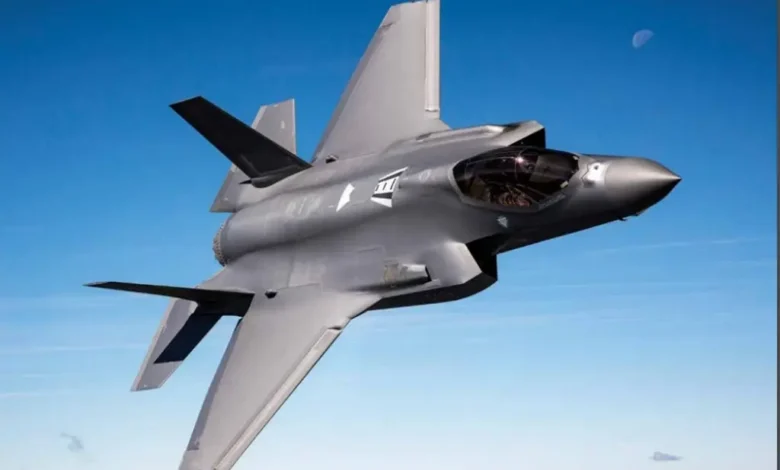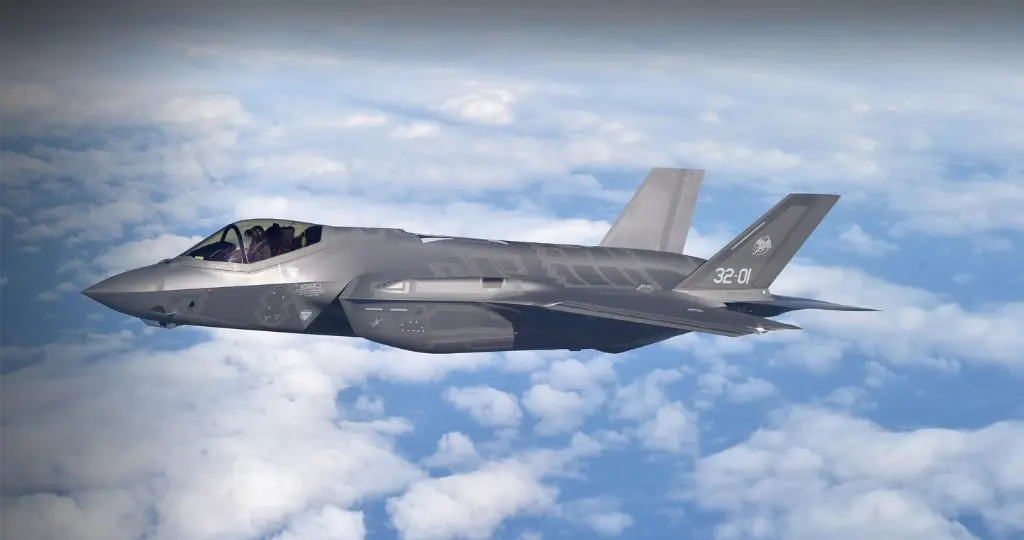F-35 Lightning II

The F-35 Lightning II is a fifth-generation multirole stealth fighter developed by Lockheed Martin. Designed to perform air superiority, ground-attack, and reconnaissance missions, the F-35 is available in three variants: the F-35A (conventional takeoff and landing), F-35B (short takeoff and vertical landing), and F-35C (carrier-based). First flown in 2006 and introduced in 2015, the F-35 is one of the most advanced and widely exported stealth fighters in the world.
Fact Sheet
| Role | Multirole stealth fighter |
|---|---|
| Manufacturer | Lockheed Martin |
| First Flight | 2006 |
| Service Entry | 2015 |
| Crew | 1 |
Specifications
| Length | 15.7 m (51.4 ft) |
|---|---|
| Wingspan | 10.7 m (35 ft) |
| Height | 4.33 m (14.2 ft) |
| Empty Weight | 13,290 kg (29,300 lb) |
| Max Takeoff Weight | 31,800 kg (70,000 lb) |
| Powerplant | 1 × Pratt & Whitney F135-PW-100 turbofan |
| Thrust | 43,000 lbf (191 kN) with afterburner |
| Max Speed | Mach 1.6 (1,975 km/h; 1,227 mph) |
| Service Ceiling | 15,240 m (50,000 ft) |
| Range | 1,380 mi (2,220 km) combat radius |
| Rate of Climb | ~45,000 ft/min (229 m/s) |
Avionics & Armament
| Main Radar | AN/APG-81 AESA radar |
|---|---|
| Avionics | Distributed Aperture System (DAS), Electro-Optical Targeting System (EOTS) |
| Armament | One 25-mm GAU-22/A rotary cannon (F-35A only); Internal bays for: – 4 AIM-120 AMRAAMs or 2 AIM-120s + 2 bombs (JDAMs, SDBs) External hardpoints for: – Additional missiles, bombs, or fuel tanks (non-stealth configuration) |
Notable Features
- Stealth technology for reduced radar cross-section.
- Multirole capability for air-to-air and air-to-ground missions.
- Advanced avionics for superior situational awareness.
- Variants tailored for conventional, STOVL, and carrier-based operations.
- Widely exported to allied nations, ensuring interoperability.

The Digital Warrior: Understanding the F-35 Lightning II
Meet the Lockheed Martin F-35 Lightning II, often called the “Joint Strike Fighter.” This isn’t just a plane; it’s a flying computer, a master of disguise, and a powerful multi-tool for modern warfare. Designed to be a flexible solution for air forces around the globe, the F-35 represents the very latest in fifth-generation fighter technology. It’s built to give pilots an unparalleled advantage, whether they’re fighting in the sky, striking targets on the ground, or gathering crucial information.
Let’s explore what makes the F-35 Lightning II such a cutting-edge and vital aircraft for today’s complex world.
A Global Effort: The Joint Strike Fighter Program
The F-35’s story began with the Joint Strike Fighter (JSF) program in the 1990s. The idea was to create a single family of advanced, affordable combat aircraft that could meet the needs of the U.S. Air Force, Navy, and Marine Corps, as well as several international allies. This ambitious program aimed to replace a variety of aging fighters and attack aircraft with one highly capable design, leading to significant savings through shared parts and development.
Lockheed Martin’s design was ultimately selected, and the first F-35 prototype took its initial flight on December 15, 2006. Since then, it has become one of the most widely adopted advanced fighter jets in history, with many countries investing heavily in its capabilities.
Three Variants, One Purpose: Tailored for Different Missions
One of the most remarkable aspects of the F-35 is its ability to adapt to different military needs. It comes in three main versions, each designed for specific operational environments:
- F-35A (CTOL – Conventional Takeoff and Landing): This is the primary version for the U.S. Air Force and most international partners. It takes off and lands like a traditional aircraft from long runways. Think of it as the standard model, highly versatile for various missions.
- F-35B (STOVL – Short Takeoff/Vertical Landing): This variant is unique, used by the U.S. Marine Corps, the UK’s Royal Air Force and Royal Navy, and the Italian Navy. It can take off from short runways (like those on amphibious assault ships) and, most impressively, can land vertically like a helicopter. This incredible capability is achieved through a special lift fan behind the cockpit and a swiveling engine nozzle.
- F-35C (CV – Carrier Variant): Designed specifically for the demanding environment of aircraft carriers, this version is used by the U.S. Navy and will be used by the UK’s Royal Navy. It features larger wing surfaces for better low-speed control, stronger landing gear to withstand harsh carrier landings, and an arresting hook to catch cables on the ship’s deck.
Despite their differences, all three variants share common stealth capabilities, advanced avionics, and a highly integrated design.
The Power of “Fifth-Generation”: What Makes the F-35 Special?
The F-35 is considered a fifth-generation fighter because it combines several cutting-edge features that work together to give it a significant advantage on the battlefield:
- Stealth (Low Observability): Like its cousin, the F-22 Raptor, the F-35 is designed to be very difficult for enemy radar to detect. Its sleek shape, special radar-absorbent materials (RAM), and internal weapon bays (meaning no bombs or missiles hanging off the wings) all contribute to a significantly reduced radar signature. This allows the F-35 to operate in highly contested airspace, getting closer to targets without being seen.
- Sensor Fusion: The Ultimate Situational Awareness: This is arguably the F-35’s most revolutionary feature. The F-35 takes information from all its sensors – its advanced radar, infrared cameras, electronic warfare systems, and even data from other F-35s or friendly aircraft – and combines it into a single, easy-to-understand picture for the pilot. This sensor fusion means the pilot isn’t overwhelmed by data but instead sees a clear, real-time view of the battlefield, threats, and friendly forces. It’s like having a superpower that lets you “see” everything happening around you, even things that are normally invisible.
- Advanced Avionics and Computing Power: The F-35 is packed with incredibly powerful computers. These systems manage everything from flight controls to weapons, communications, and sensor fusion. This massive computing power allows for constant analysis of the combat environment, reducing the pilot’s workload and letting them focus on making smart tactical decisions.
- Network-Centric Warfare: The F-35 isn’t just a powerful individual fighter; it’s a crucial node in a larger network. It can share its rich “fused” sensor data with other F-35s, older aircraft (like F-16s), ships, and ground units in real-time. This ability to instantly share and receive information creates a much more effective and coordinated fighting force, allowing everyone to act based on the same, complete picture of the battle.
- Supercruise (Limited): While not as pronounced as the F-22’s capability, the F-35 can achieve supersonic speeds without always relying on its afterburners, improving its range and efficiency when going fast.
A Multi-Role Master: Weapons and Missions
The F-35 is a true multirole combat aircraft, capable of performing a wide range of missions:
- Air-to-Air: It carries AIM-120 AMRAAM missiles for engaging enemy aircraft at long ranges and AIM-9 Sidewinder missiles for closer combat. The F-35A also has an internal 25mm cannon, while the F-35B and F-35C can use an external gun pod if needed.
- Air-to-Ground: For striking targets on the ground, the F-35 can deploy Joint Direct Attack Munitions (JDAMs), Small Diameter Bombs (SDBs), and other precision-guided weapons. Its stealth allows it to deliver these weapons effectively even in heavily defended areas.
- Intelligence, Surveillance, and Reconnaissance (ISR): With its advanced sensors, the F-35 can collect vast amounts of intelligence about enemy positions, movements, and electronic emissions, providing vital information to commanders.
- Electronic Warfare (EW): The F-35 can detect, track, and jam enemy radar and communication systems, making it difficult for adversaries to operate effectively.
Global Adoption and Ongoing Evolution
The F-35 program is the largest defense program in history, with over 1,000 F-35s delivered to date. Lockheed Martin expects to deliver between 170 and 190 F-35s in 2025, including both newly built aircraft and those previously stored awaiting upgrades. The cost of individual F-35s has significantly decreased since the program’s early days, with the F-35A unit price now below $80 million in current production lots.
Many countries are operating or planning to operate the F-35, including:
- United States (USAF, US Navy, US Marine Corps)
- United Kingdom
- Italy
- Norway
- Australia
- Netherlands
- Israel
- Japan
- South Korea
- Belgium
- Denmark
- Finland
- Poland
- Germany
- Singapore
- Switzerland (future operator)
- Greece (future operator)
- Czech Republic (future operator)
The F-35 is continuously being upgraded. The current major effort is the Technology Refresh 3 (TR-3), which provides significant improvements in computing power, memory, and display systems. TR-3 is the foundation for the upcoming Block 4 modernization, which will introduce even more advanced radar, enhanced sensors, improved electronic warfare capabilities, and integration of a wider range of new weapons (including the AIM-260 JATM and Meteor missiles). Future upgrades are even looking into advanced stealth coatings, better cooling systems, and potentially even optionally unmanned operations for the F-35.
The Future of Air Power
The F-35 Lightning II represents a paradigm shift in air combat. It’s not just about how fast it flies or how many weapons it carries; it’s about its ability to see first, act first, and dominate the information space. As more F-35s enter service around the world and receive continuous upgrades, they will form the backbone of air power for decades to come, ensuring a powerful and connected force for global security.



